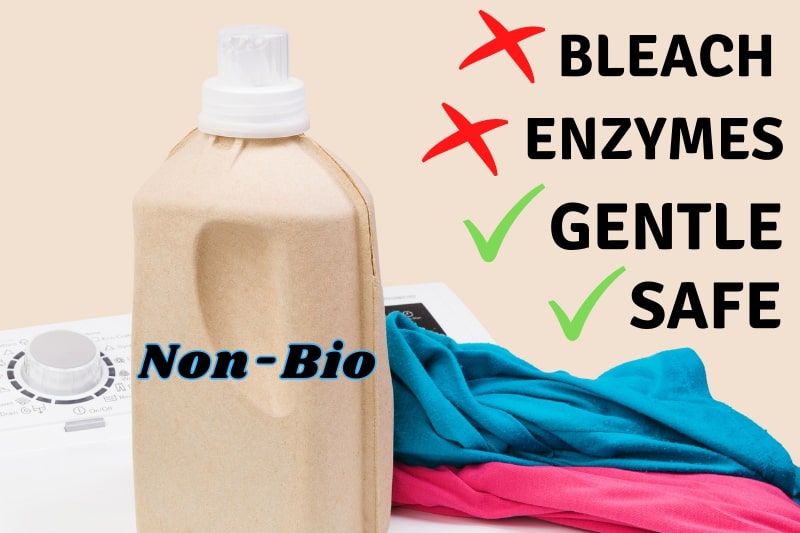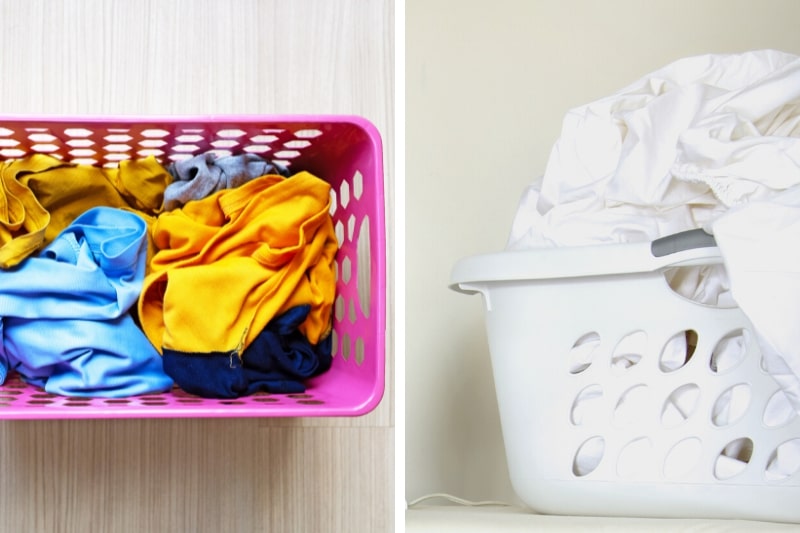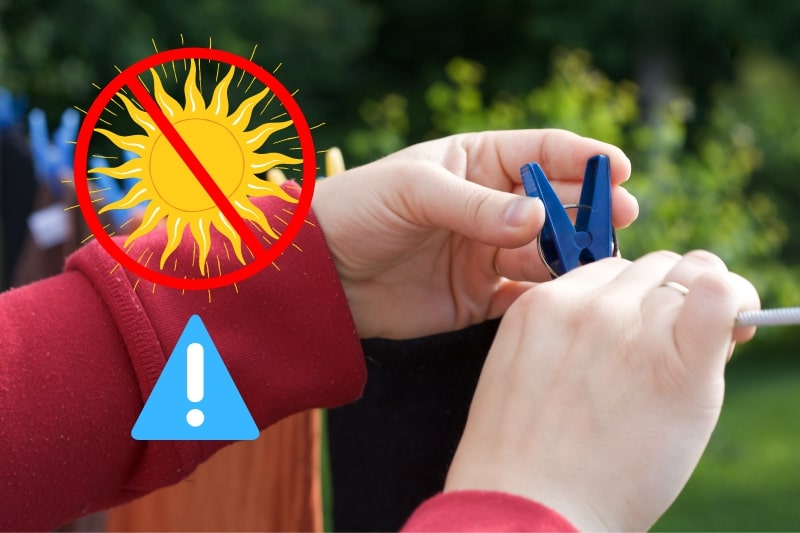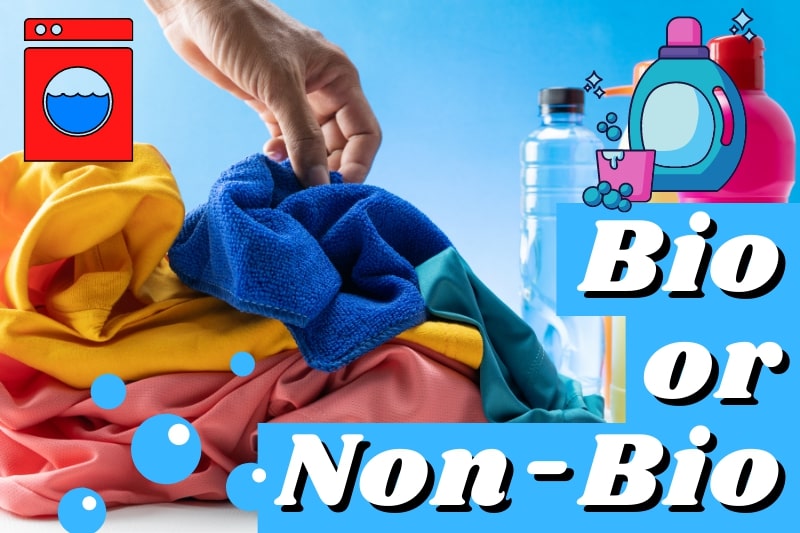The laundry market is awash with detergents that promise to achieve dazzling whites, so trying not to bleach your coloured loads can feel like navigating a minefield. Between biological and non-biological, which detergent is safest for colours?
The enzymes in biological detergents can break down proteins within some coloured dyes, causing colours to fade. Bio products may also contain bleach, which whitens colours.
This means it’s best to use non-bio for colours, since non-bio detergents are gentler on the dyes in your coloured fabrics.
Within the rest of this article, I’ll discuss the differences between bio and non-bio detergents and investigate why non-bio is better for colours. I’ll also provide some tips for keeping your coloured loads looking vibrant and recommend some non-biological detergents for retaining your colours.
What’s the Difference Between Bio and Non-Bio?
There are a few differences between bio and non-bio, but, basically, there’s less stuff in non-bio detergent.
I’ll go over some key ingredients contained within bio detergents and highlight their purpose.
Enzymes
The main difference between bio and non-bio detergent is that biological detergent contains enzymes.
Enzymes are natural chemicals that can be found in the digestive systems of most animals. They break down grease, proteins, and fat to help animals absorb nutrients from food.
Their natural ability to break down proteins means that enzymes are great for removing dirt and stains from laundry. This is because many common laundry stains – like food, sweat, and blood – are composed of proteins.
The first biological detergent was created in Germany in 1913, when enzymes from the pancreases of slaughtered animals were successfully added to laundry detergent.
Bio detergent became more advanced throughout the following century, and it’s now mass-produced using enzymes from genetically engineered bacteria.
Bleach
While some non-bio detergents may still contain bleach, it’s far more commonly found within bio detergents, since they’re generally formulated to take tougher action against stains.
Bleach is used to make clothes whiter. It also destroys bacteria that clings to your clothes, making fabrics more hygienic.
Stabilisers
If an enzyme stays active, it will break down faster and become ineffective. To stop enzymes from falling apart before they can work on your laundry, bio detergents contain stabilisers.
Stabilisers preserve enzymes, ensuring they’re only activated under certain conditions (such as when they reach a certain temperature or encounter water).
Why Is Non-Bio Better for Colours?

Non-bio detergents are missing the harsh components of bio detergent. Bio detergent’s ingredients make it perfect for battling filth, but not so great for protecting colours.
The enzymes present in biological detergent can sometimes break down the proteins that construct certain fabric dyes. Many fabric dyes are derived from natural sources, meaning they can be broken down by enzymes just like other chemicals.
This means that the enzymes within bio detergent can cause some colours to fade.
Similarly, the bleach commonly present in bio detergent can also destroy colours through the process of oxidisation.
Therefore, non-bio detergent is gentler on colours and best for protecting your dyed fabrics.
Tips for Washing Colours
Want to know how to retain the vibrant colours in your favourite clothes? Here are a few tips!
1. Use a gentle non-bio detergent

The first step to protecting your coloured fabrics is choosing a gentle non-bio detergent to wash them with. Luckily, I’ve got you covered with some non-bio detergent recommendations – including both liquid and powder!
Best non-bio detergents for washing colours
1. Ecozone Non-Bio Laundry Liquid
Liquid detergents tend to be best for washing colours, since they’re less likely to contain bleach or enzymes, and Ecozone’s liquid detergent is a prime example.
Customers love its eco-friendliness since it lacks harsh chemicals or dyes. Plus, it’s popular among Mumsnet users due to its colour-retaining properties – although one user points out that clothes will inevitably fade over time, regardless of the detergent you use.
You can find Ecozone Non-Bio Laundry Liquid for a competitive price on Big Green Smile alongside customer reviews.
2. Persil Non-Bio
Persil is a trusted laundry brand, so, unsurprisingly, its non-bio washing powder does an excellent job at washing colours.
One happy customer called this the best non-bio washing powder available, which seems to be a common sentiment throughout its reviews.
However, some reviewers felt that this powder was ineffective at removing stains since non-bio tends to be gentler on clothes. From a colour-retaining perspective, though, Persil Non-Bio is worth a spin.
Check out its price and reviews on Amazon.co.uk.
3. Ecover Non-Bio Lavender & Sandalwood Washing Liquid
Here’s another non-bio liquid detergent to try if Ecozone isn’t cutting it for you!
Ecover’s environmentally friendly detergent is a hit with customers, who love its gentle pleasant fragrance and potent cleaning power (for a non-bio detergent). Some customers also note that it cleans colours brilliantly, but that’s usually not the focus of their reviews.
A downside to this product is its hefty price tag compared to other detergents, but its followers feel that it’s worth the investment.
Judge Ecover’s non-bio detergent for yourself; you can find its price and reviews on Big Green Smile.
2. Read the washing instructions

Use our guide to deciphering washing label symbols, and ensure you follow the instructions to avoid any coloured dyes from fading.
3. Use a gentle cycle
Stop your fabrics from being damaged in the wash by setting your washing machine to a gentle cycle. This will minimise the tearing of materials, reducing the likelihood of colours leaving the fabric strands.
It’s also prudent to use a low-temperature wash to protect your colours.
4. Sort clothes by colour

If you ever took art classes in school, you’re probably familiar with the colour wheel. To be extra certain that your coloured clothes don’t run or fade, group hot and cold colours into separate washes to stop blue dye seeping into your yellow t-shirt.
You should also separate dark and light washes, isolating pure white fabrics into their own cycle.
5. Turn clothes inside out
Turning clothes inside out is a particularly good tip for newly bought clothes with dye that’s still highly saturated: turn your clothes inside out before washing them.
This will stop the outward-facing coloured fibres from rubbing against other clothes in the machine, keeping fabric intact for longer.
6. Line dry – but not in direct sunlight!

To keep colours vibrant, it’s best to avoid the rough treatment of the tumble dryer and simply dry your clothes naturally.
However, the sun’s UV rays will bleach your coloured fabrics, causing them to fade; you should line dry coloured clothes out of direct sunlight.
Conclusion
To protect your colours in the wash, it’s best to use a non-bio detergent that doesn’t include bleach, enzymes, or optical brighteners. However, there are also bio detergents that are specially formulated to wash colours gently.
I’ve provided some non-bio detergent recommendations for retaining colours, but you don’t have to avoid the specialist bio detergents for colours. Try various detergents and see what works best for you.
Detergent is just one piece of the puzzle when you’re trying to retain your clothes’ colours. You should also: follow the washing instructions on your clothes’ label; separate lights and darks; separate hot and cold colours; wash clothes inside out; and line dry colours while keeping them out of direct sunlight.

A recent uni graduate who likes writing, gaming, and drawing. I’m figuring out housekeeping tips alongside you while trying to provide eco-friendly cleaning options. Let’s find out how to use a tumble dryer together!



